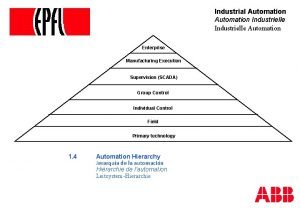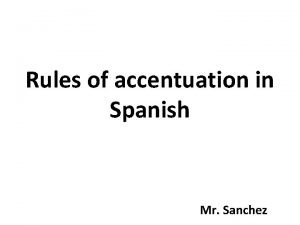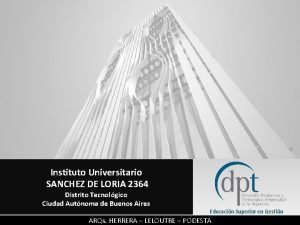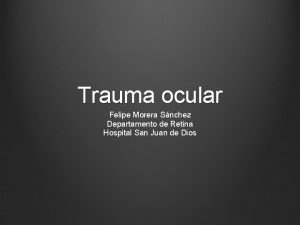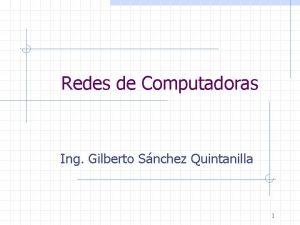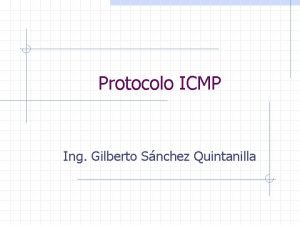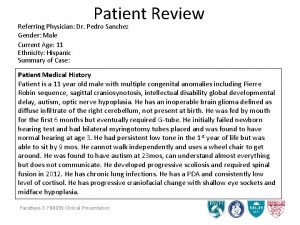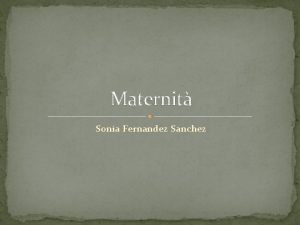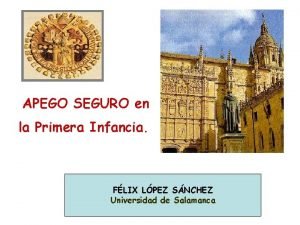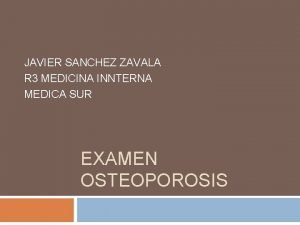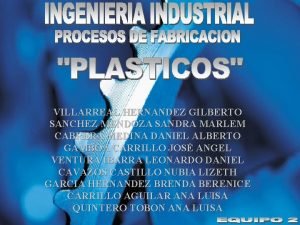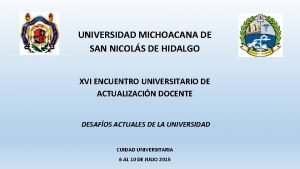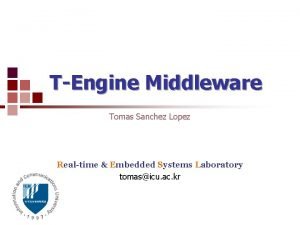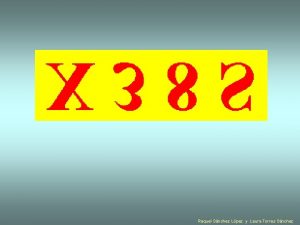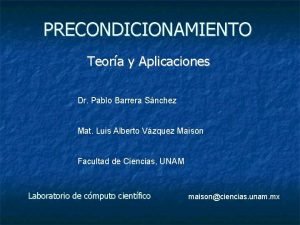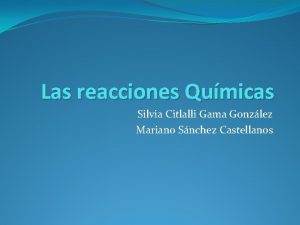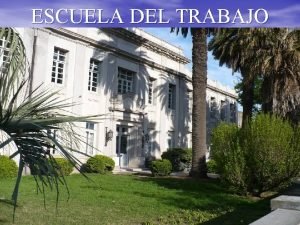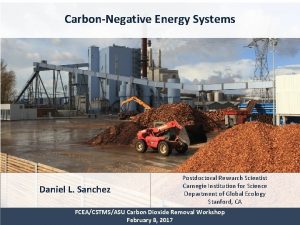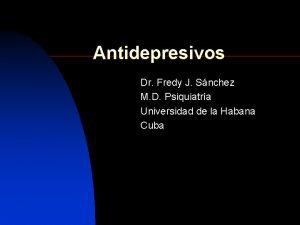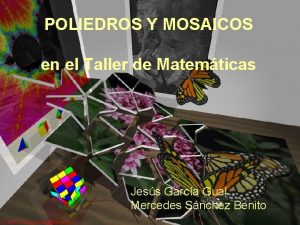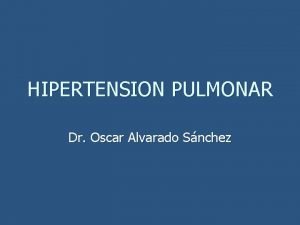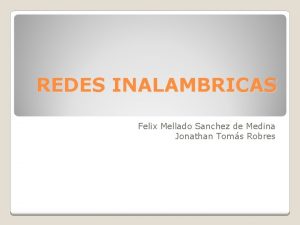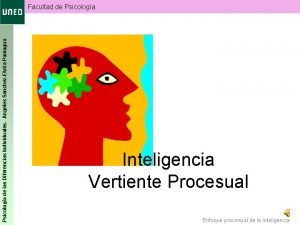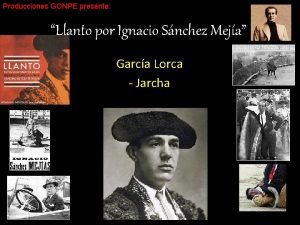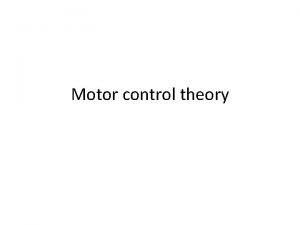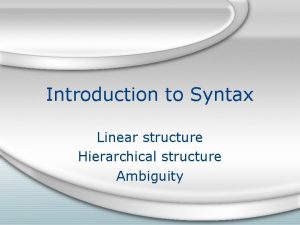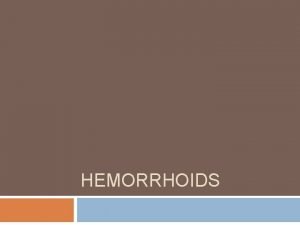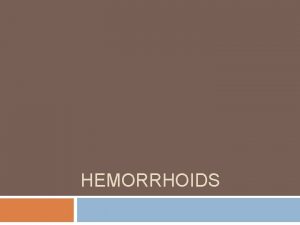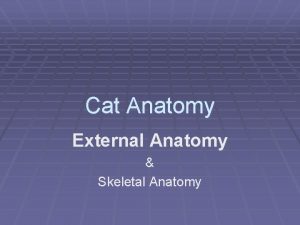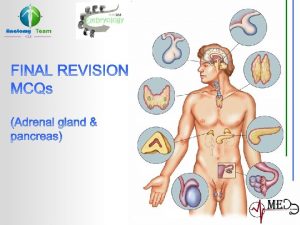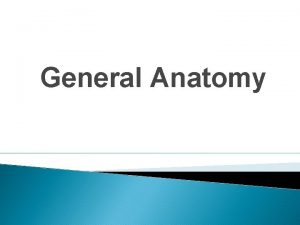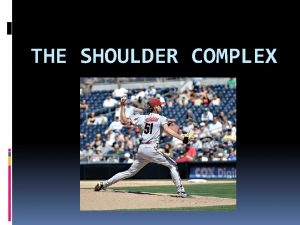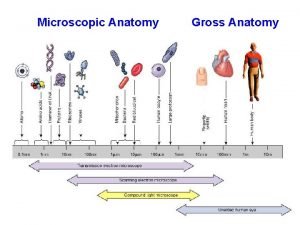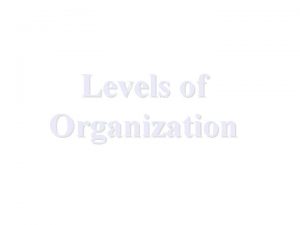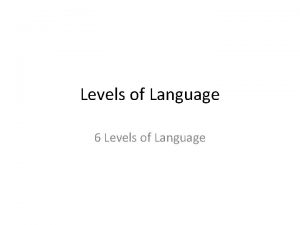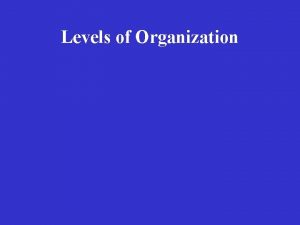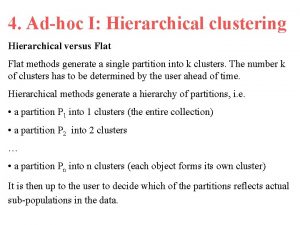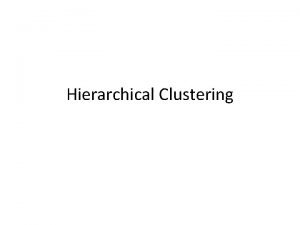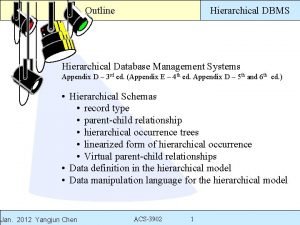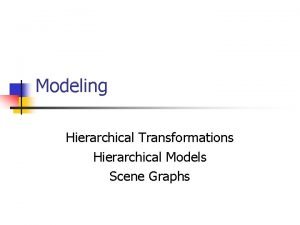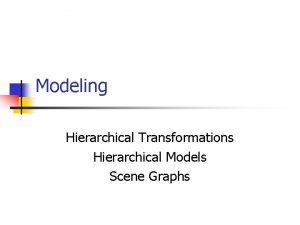Hierarchical Levels of Anatomy Prof Sanchez Hierarchical Levels




















































- Slides: 52

Hierarchical Levels of Anatomy Prof. Sanchez

Hierarchical Levels of Anatomy There are six hierarchical levels of anatomy and physiology. (1) Chemical level (2) Cellular level (3) Tissue level (4) Organ level (5) Organ system level (6) Organism level

The Chemical Level (Atomic and Molecular Level) • The story of biology begins in chemistry. • We must have a basic understanding of chemistry to understand biology. This is because, everything that is made up of matter (from rocks to human beings) is made up of atoms. • The Chemical Level Includes the Atomic Level and Molecular Level of our Bodies This Photo by Unknown Author is licensed under CC BY-SA-NC

This Photo by Unknown Author is licensed under CC BY-NC-ND The story of YOU • The story of YOU is more beautiful and complex than you can ever image! Many scientists believe that our universe started with a "BIG BANG" or a "BIG BANG-LIKE" event. • The universe we live in was created by some type of BANG that contained all of the subatomic particles needed to make matter. • In the beginning, the early universe was too hot for atoms to form, but as the universe cooled the first atoms were able to form.

We are all made of stars! • The first atoms to form were hydrogen and helium. • Hydrogen is made up of only 1 electron and 1 proton. • Helium is made up of 2 electrons and 2 protons. • Stars are made up almost entirely of hydrogen and helium. • All of the heavier elements are made when a star dies and explodes as a super nova. This Photo by Unknown Author is licensed under CC BY-NC-ND

We are all made of stars! • The matter that you are made of has been around since the beginning of the universe 13 billion years ago. • All of the heavier elements required for life like you and I to exist, were form in the cauldron of an exploding star. This Photo by Unknown Author is licensed under CC BY-NC

ATOMS - What's the MATTER? • All matter in the universe as we know it, is made up of atoms. • It is for this reason that we define the atom as the fundamental unit of matter.

The Atom • Atoms are made up of a combination of subatomic particles, which are protons, electrons and neutrons. This Photo by Unknown Author is licensed under CC BY-NC

The Atom • PROTONS are positively charged and are found at the nucleus (center) of the atom. ELECTRONS are negatively charged and are found on the outer portions of the atom. NEUTRONS have no charge and are found in the nucleus of the atom.

96% of all living matter is composed of only 4 atoms (elements)!

Carbon Hydrogen Oxygen Nitrogen

Hydrogen The simplest and most abundant atom is the hydrogen atom. The hydrogen atom contains only one electron and one proton. An atom, by definition, is neutral (uncharged). That means in an atom, the number of protons will equal the number of electrons.

• An atom is made up of subatomic particles. • The nucleus (or center) of the atom is made up of one or more positively charged subatomic particles called protons and uncharged subatomic particles called neutrons.

• Almost all of the mass of the atom is located in the nucleus. • Electrons "orbit" the nucleus of the atom. • The electron(s) that are located on the outermost portion of the atom can participate in chemical reactions and can create bonds with other atoms. Atoms

Atoms are Essentially EMPTY SPACE!

Molecules WHAT IS A MOLECULE?

Molecules When an atom forms a bond with one or more other atoms, it is called a molecule. A molecule is made up of one or more atoms.

Diversity of Molecules Sometimes these molecules are small and simple. We can take oxygen as an example. Oxygen is a gas that is made up of simply 2 oxygen molecules that are bound together (02).

Diversity of Molecules Some molecules consist of thousands of atoms (macromolecules) like DNA and proteins.

4 most important molecules for LIFE! • Proteins, lipids, carbohydrates and nucleic acids are the 4 most important molecules for the cell, and for life in general. This Photo by Unknown Author is licensed under CC BY-SA

Proteins • Amino Acids Bond Together Forming Proteins

Nucleic Acids are polymers that are formed from a long string composed of a single monomers, called nucleotides. Nucleic acids includes our DNA and RNA. DNA stands for Deoxyribonucleic acid and RNA stands for Ribonucleic Acid. Nucleic Acids includes DNA and RNA.

Function of Nucleic Acids • DNA and RNA function in coding and transferring genetic information. • DNA functions as the master "instruction manual" that has all of the information on how that cell should develop and hold the instructions for making proteins which act out the various functions of the cell.

Single Sugar Units (monosaccharides) Bond Together Forming Large Carbohydrate Molecules (polysaccharides)

Carbohydrates • Carbohydrates get converted into energy in the body through our metabolism. • Our metabolism breaks down the glucose molecule and creates ATP. • ATP is the principle energy source for the cell. • ATP is often called "the energy currency of the cell". This Photo by Unknown Author is licensed under CC BY-SA

Carbohydrates • Monosaccharides are simple sugars composed of one sugar molecule. Glucose is an example of a monosaccharide.

Carbohydrates • Disaccharides are composed of 2 sugar molecules bound to each other. Sucrose (table sugar) is an example of a disaccharide. This Photo by Unknown Author is licensed under CC BY-SA

Carbohydrates • Polysaccharide are sugar (or carbohydrates) that are formed from long chain of monosaccharides bound together, Starch is an example of a polysaccharide.

Fatty Acids are Important Components of Lipids. Fatty Acids

Components of Lipids. • PHOSPHOLIPIDS CONTAIN 2 FATTY ACID TAILS AND MAKE UP THE PLASMA MEMBRANE OR CELL MEMBRANES FOR EACH OF OUR 100 TRILLION CELLS

This Photo by Unknown Author is licensed under CC BY The Cellular Level • The cell is the fundamental unit of life. • All living things are made up of one or more cells.

Cells • Cells and their surroundings are made up of molecules. • It takes about 100 trillion atoms to make a typical cell. This Photo by Unknown Author is licensed under CC BY

Wide Diversity of Cell Types • There Are More Than 200 Types of Cells in the Human Body

Cells of similar types come together to form tissues. The Tissue Level A TISSUE is a group of two or more cells (of similar function or origin) that come together to perform a common function.

There are 4 types of tissues • Epithelial (skin) Tissue • Connective Tissue • Nervous Tissue • Muscle Tissue This Photo by Unknown Author is licensed under CC BY-SA

epithelial tissue • Epithelial cells come together to form epithelial tissue. This Photo by Unknown Author is licensed under CC BY-SA

Muscle Tissue • Muscle Cells (Muscle Fibers) come together to form muscle tissue. • The body contains three types of muscle tissue: • (a) skeletal muscle, • (b) smooth muscle, and • (c) cardiac muscle. This Photo by Unknown Author is licensed under CC BY-NC

The Organ Level • Different tissue types come together to form organs. • An organ is a discrete structure made up of more than 2 different tissue types that work together as a functional unit for the body.

An organ system is a group of organs and associated structures that perform a specific function in the body. The Organ System Level There are 11 Organ Systems of the Human Body.

The Integumentary System The integumentary system includes the skin, the hair and the nails of the body. It is also considered an organ. In fact, the integumentary system is the body's largest organ. This system provides protection and helps regulate body temperature.

The Circulatory System The circulatory system (or cardiovascular system) includes the heart, the blood and the blood vessels. The function of the circulatory system is to move blood, nutrients, oxygen, carbon dioxide, and hormones, around the body.

The Muscular System The muscular system is an organ system consisting of skeletal, smooth and cardiac muscles. It permits movement of the body, maintains posture and circulates blood throughout the body. The muscular systems in vertebrates are controlled through the nervous system although some muscles can be completely autonomous.

The skeletal system • The skeletal system includes the 206 named bones of the body, as well as the tendons, ligaments and cartilage that actively support it. The function of the skeletal system is to allow for movement, provide structure, produce blood cells and to store calcium.

The digestive system • The digestive system includes the mouth, esophagus, stomach, small intestine, large intestine, rectum, and anus. • There also accessory digestive organs like the liver and pancreas that assist the digestive system. • The function of the digestive system is to break down food, absorb nutrients, and eliminate waste as feces.

The immune system • The immune system is the body's defense against disease. The immune system includes the includes, the thymus and the leukocytes (white blood cells) of the body.

The immune system • The lymphatic system includes lymph nodes, lymph ducts and lymph vessels, and also plays a role in the body's defenses. • Its main job is to make and move lymph, a clear fluid that contains white blood cells, which help the body fight infection. • The lymphatic system also removes excess lymph fluid from bodily tissues, and returns it to the blood.

The nervous system • The nervous system includes the brain, the spinal cord, peripheral nerves and sensory receptors. • The nervous system senses the conditions of our internal and our external environments. • Responses and commands are sent from the brain and spinal cord to muscles of the body. • Much of the function of the nervous system is not under conscious control.

The endocrine system • The endocrine system includes the eight major glands of the body that secrete hormones. • Hormones function to regulate many of the body's functions including growth, metabolism, and sexual reproduction.

The reproductive system • The reproductive system allows humans to reproduce. • The male reproductive system includes the penis and the testes, which produce sperm. • The female reproductive system consists of the vagina, the uterus and the ovaries, which produce eggs. • During conception, a sperm cell fuses with an egg cell, which creates a fertilized egg that implants and grows in the uterus.

The urinary system • The urinary system helps eliminate a waste product called urea from the body, which is produced when certain foods are broken down. • The whole system includes two kidneys, two ureters, the bladder, two sphincter muscles and the urethra. • Urine produced by the kidneys travels down the ureters to the bladder, and exits the body through the urethra. This Photo by Unknown Author is licensed under CC BY-SA-NC

The respiratory system • The respiratory system allows us to take in vital oxygen and expel carbon dioxide in a process we call breathing. It consists mainly of the trachea, the diaphragm and the lungs.

The Organism Level • The level of the organism looks at how all of the anatomical structure of body work together to provide all of the necessary function for life.
 Industrial automation levels
Industrial automation levels Accentuation in spanish
Accentuation in spanish Daniel sanchez the voice
Daniel sanchez the voice Sánchez de loria 2364
Sánchez de loria 2364 Omayra sanchez black eyes
Omayra sanchez black eyes Charisma sanchez
Charisma sanchez Arnold sanchez ordaz
Arnold sanchez ordaz Omayra sanchez
Omayra sanchez Felipe morera sanchez
Felipe morera sanchez Sanchez quintanilla gilberto
Sanchez quintanilla gilberto Sanchez quintanilla gilberto
Sanchez quintanilla gilberto Respuesta desde host de destino inaccesible
Respuesta desde host de destino inaccesible Exophthalmos
Exophthalmos Sonia fernandez sanchez
Sonia fernandez sanchez Shawntell mills-sanchez
Shawntell mills-sanchez John williams mit
John williams mit Félix lópez sánchez
Félix lópez sánchez Hector antuna sanchez
Hector antuna sanchez Vive le vent en portugais
Vive le vent en portugais Vinny sanchez dla piper
Vinny sanchez dla piper Escuela vocacional especial
Escuela vocacional especial Juan javier sanchez zavala
Juan javier sanchez zavala Gilberto sanchez partida
Gilberto sanchez partida Maria de la luz moctezuma lópez sánchez juárez
Maria de la luz moctezuma lópez sánchez juárez Gdt european wildlife photographer of the year
Gdt european wildlife photographer of the year Tomas sanchez lopez
Tomas sanchez lopez Raquel sanchez
Raquel sanchez Pablo barrera sánchez
Pablo barrera sánchez Alexandre farnèse
Alexandre farnèse Mariano sanchez castellanos
Mariano sanchez castellanos Raphael sanchez ibm
Raphael sanchez ibm Anabella sanchez historia del arte
Anabella sanchez historia del arte Daniel l sanchez
Daniel l sanchez Bloqueadores alfa adrenergicos
Bloqueadores alfa adrenergicos Poliedro sanchez
Poliedro sanchez Anni sanchez
Anni sanchez Ing carlos sanchez
Ing carlos sanchez Trauma hepatico clasificacion
Trauma hepatico clasificacion Estándares wifi
Estándares wifi Angeles sanchez elvira paniagua
Angeles sanchez elvira paniagua Juanito belmonte
Juanito belmonte Sanchez devanny queretaro
Sanchez devanny queretaro Instituto miguel sanchez hinestroza
Instituto miguel sanchez hinestroza Yesid sanchez
Yesid sanchez Costa's level of thinking questions
Costa's level of thinking questions Task analysis
Task analysis Hierarchical linear regression spss
Hierarchical linear regression spss Flat addressing vs hierarchical addressing
Flat addressing vs hierarchical addressing Hierarchical regression
Hierarchical regression Hierarchical bayesian model
Hierarchical bayesian model Hierarchical bayesian model
Hierarchical bayesian model Motor control theory
Motor control theory Structural ambiguity nedir
Structural ambiguity nedir
